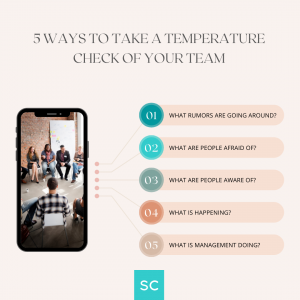Crafting Your Message In Stressful Situations
As a leader, you are not the judge of your communications ability. Even if you are a C-suite executive, the true test is what other people think. And when something happens that majorly impacts your team, they will be looking to you for guidance and reassurance. If you aren’t carefully crafting your message, people can be left feeling isolated and disengaged.
In a crisis situation, some leaders fall into the trap of simply saying what is on their minds. They react quickly. But there is a difference between reacting and thoughtfully responding.
It’s what other people think and how understandable they feel you are.
This is why it is always helpful to have a second pair of eyes reading or reviewing your material. As you begin to craft the first draft of your communications, keep in mind your audience and what they care about. Understanding your audience’s perspective is key to crafting a powerful message.
Make Your Message Powerful
 In order for you to make your message powerful, you have to make it relatable. In other words, bring the message down to Earth.
In order for you to make your message powerful, you have to make it relatable. In other words, bring the message down to Earth.
There are a few ways you can be more relatable as a leader:
Staying In Touch – If you are speaking to someone only when you need something, the relationship will come off as not genuine and very transactional. So staying in touch, even when you don’t need something will help you be more relatable (and likable!)
Putting the focus on others – When you put the focus on others, you show that you don’t always have to be the center of all conversations or the center of the relationship. If you give credit to others, they will give you credit too.
Be yourself – Most people can tell when you are being disingenuous. It is possible to be yourself and be in a professional leadership position.
Here are our recommendations for how you can strategically craft your message, especially when things are tricky
1. Temperature Check
 If something is going haywire, it’s important to get a temperature check before crafting your response. Once you find out the temperature check of the situation, you’ll want to make sure that you are speaking to their emotions, otherwise, they will walk away with a lot more questions.
If something is going haywire, it’s important to get a temperature check before crafting your response. Once you find out the temperature check of the situation, you’ll want to make sure that you are speaking to their emotions, otherwise, they will walk away with a lot more questions.
There are a few ways to get the temperature of everyone’s emotions.
- Find out what the rumors are going around right now.
- What are people saying that they’re afraid of?
- What are people aware of?
- What are people not aware of?
- What is happening outside of the organization that is having an internal effect?
- What is management doing on the daily to address the situation?
Once you have your temperature check, be ready to address these questions head-on and honestly.
2. Be Personal
One effective strategy in having your communications resonate is by adding a personal touch. In high-stakes situations, this is also important too.
There is a difference between sharing something that is private versus sharing something that is personal.
Personal means you are showing empathy. In fact, leaders who show empathy are often seen as more effective and relatable.
Examples of sharing something that is personal include:
- Sharing a conversation that you had with someone
- Sharing how you felt when you first learned of the situation at hand
By sharing something more personal, you are showing that you are living and breathing this moment with everyone else. It also shows that you understand the gravity of the situation.
Part of being more personal is understanding emotional intelligence or EQ. Leaders with high emotional intelligence understand the significance of communicating effectively with their teams. Being relatable, or more personal is one way you can become a more emotionally intelligent leader.
3. Map Out Your Message
What exactly are you going to say and how exactly are you going to share your message? The truth is when there is uncertainty, you will want to take the time to truly focus on your message before you send it.
Mapping out your message is how you can ensure that what you say is received the way it was intended and that everyone actually sees or hears your message.
Map out your message by answering these questions carefully:
Who is your audience? – Sometimes you will have multiple audiences for your message. Decide who falls into each audience group and craft your message so it resonates with what they care about.
What do they need to know – Depending on the audience, you will need to decide what each audience needs to know. Remember, you don’t want to leave out key details. You also don’t want to give too much information if it is unnecessary.
When do they need to know – It is important that the information you give is done in a timely manner. It will only hurt your executive presence if teams or team leaders find out something after it is too late.
Why is this important – Why are you providing this information and is there a call to action required? Make sure it is clear!
In the end, what makes a message resonate is how relatable it is to those who are listening. As a leader, your job is to show empathy and understanding. This is especially true when times are tough.
Do your research and get a temperature check of the situation. Carefully mapping out how you want to address a situation will help everyone feel like they’re on board and informed.
__
Whenever you’re ready, there are 3 ways we can help you:
- Discover your communications style so you know where to start. Over 4,000 people have found theirs here.
- Attend our monthly communication workshop to build communications confidence (new topics: public speaking, advocating for yourself, building credibility, etc) here.
- Get your brand in front of 43k+ people by sponsoring our newsletter or Soulcast Media | LIVE LinkedIn events [contact: hello@soulcastmedia.com]











